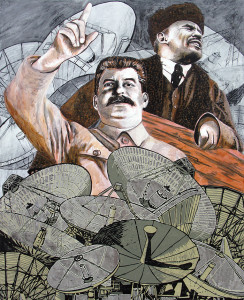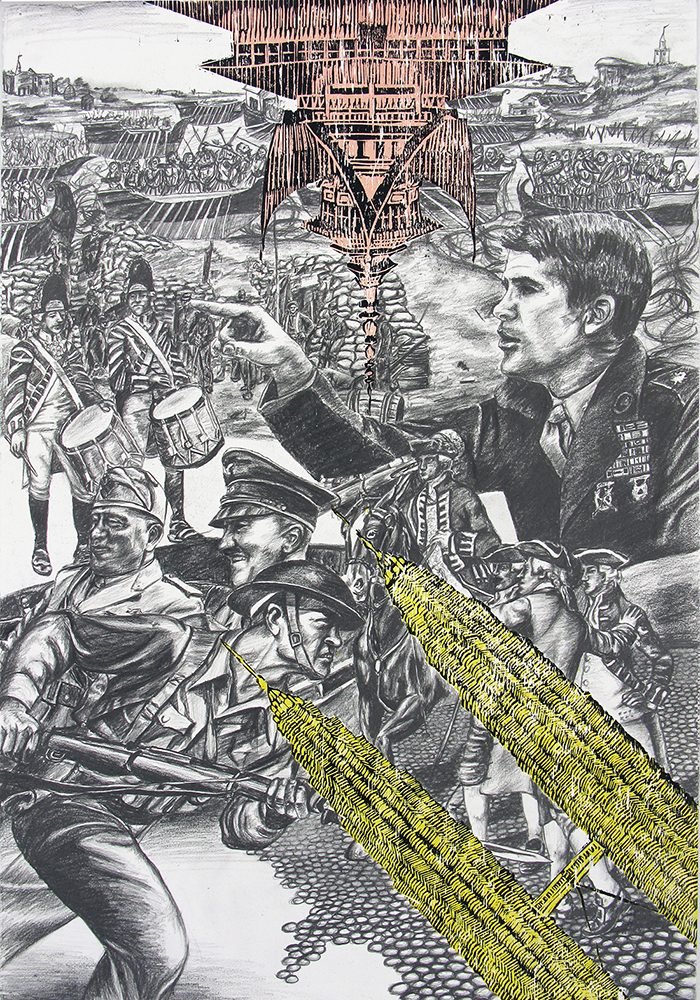With the current political climate of the United States, Erin Hoffman found inspiration in the madness, by creating art, while also referencing the history of politics and democracy.
Hoffman is one of the many artists, who submitted her work to the College Arts Association, which resulted in her getting chosen as one of the artists to showcase her exhibition, “Reflections From the Cradle of Democracy” in Building 14 in The Burnell R. Roberts Triangle Gallery.
“[The College Arts Association] is an organization that’s associated with a higher education,” Hoffman said. “They have an opportunities page and gallery submit requests for exhibition proposals.”
Although it’s not Hoffman’s first time exhibiting her work, she has showcased her work throughout the country.
“I show in art exhibitions around the area I live in, in Muskegon, Michigan, but also nationally,” Hoffman said. “The last solo exhibition I had was at Saginaw Valley State University in Michigan—that was last November.”
As a result of not fitting in during school, Hoffman said she found herself in the art department. Essentially, for Hoffman, art became something that was more than just a hobby—it was a potential career.
“Coming out of high school, [art] was the only thing I could really see doing for a really long time. It was the thing I was most interested in,” Hoffman said.
Alongside of being an artist, Hoffman also teaches art at Muskegon Community College. Part of the requirements as an art professor is that the faculty must do research, which also involves exhibiting artwork.
 “It’s sort of part of the active practice of being an artist—you make stuff and then you show it at places. It’s just one of those things because I am in academia, I am required to do research in my field of study and this is what they consider research. It’s silly to make a bunch of artwork and then have it under your bed,” Hoffman said.
“It’s sort of part of the active practice of being an artist—you make stuff and then you show it at places. It’s just one of those things because I am in academia, I am required to do research in my field of study and this is what they consider research. It’s silly to make a bunch of artwork and then have it under your bed,” Hoffman said.
She has been teaching for 12 years, and teaches a variety of art classes, such as multiple drawing classes, art appreciation, painting, contemporary art history, along with many others.
“I teach a whole bunch of stuff,” Hoffman said. “What I don’t teach is three-dimensional.”
Hoffman works with a combination of different medias; lithography being one of them. Lithography is a printmaking technique that is based on the fact that oil and water don’t mix, according to Hoffman.
“You draw with an oily crayon on a specific surface and then you treat it—there’s some chemistry involved. Then basically when you print it, you are sponging it off with water and then rolling it up with oil based ink,” Hoffman said. “It ends up looking like kind of a charcoal drawing or a black crayon drawing.”
Her exhibitions consist of lithography as well as combining relief printing. Hoffman said many of her pieces always incorporate printed elements.
“A lot of times I’ll do printed work and then have some kind of hand painted element as part of the piece or I did a few with graphite drawing in the background. I did the printed part of the drawing and then added hand-drawing elements too. I kind of mix medium,” Hoffman said.
Reductive wood cut is another element that Hoffman focuses on, while mixing medium. Many times she said she’d combine hand drawings, such as graphite drawings in the background of her reductive wood cut pieces.
Hoffman said she hopes to introduce new content and ideas to the art gallery spectators. Her goal is for her audience to leave the gallery viewing an image in a different way.
“I hope that I introduce them to something they haven’t thought about already—maybe thinking about history or politics in a different way than they thought before,” Hoffman said. “Usually there is some element of collage —the combo of different kind of images in one picture. There’s always some kind of historical or political reference.”
Hoffman had the chance to visit Italy a few years ago and found inspiration throughout Rome. She said she was attracted to the structure of the Greek and Roman sculptures, which resulted in her thinking about the early stages of democracy.
“I was thinking about how Greece and Rome were the earliest stages of democracy,” Hoffman said. “I was thinking about what they would think about the current democracy in the U.S..”
The world is surrounded by art, according to Hoffman, which is why it is so important to creatively embrace current events. Everything is part of art, which is why Hoffman makes her argument clear about why art should be acknowledged throughout everyday life.
 “You can be in business or manufacturing, but the reason that life is exciting is because of the arts—it’s everywhere. I am looking at my desk right now and everything is designed—someone thought about the color and the form, so just recognize that it is everywhere,” said Hoffman.
“You can be in business or manufacturing, but the reason that life is exciting is because of the arts—it’s everywhere. I am looking at my desk right now and everything is designed—someone thought about the color and the form, so just recognize that it is everywhere,” said Hoffman.
The Burnell R. Roberts Triangle Gallery will be hosting Hoffman’s exhibition titled, “Reflections From the Cradle of Democracy” from February 3 to February 26. For more information visit www.sinclair.edu/student-life/art-galleries.
Gabrielle Sharp
Executive Editor


